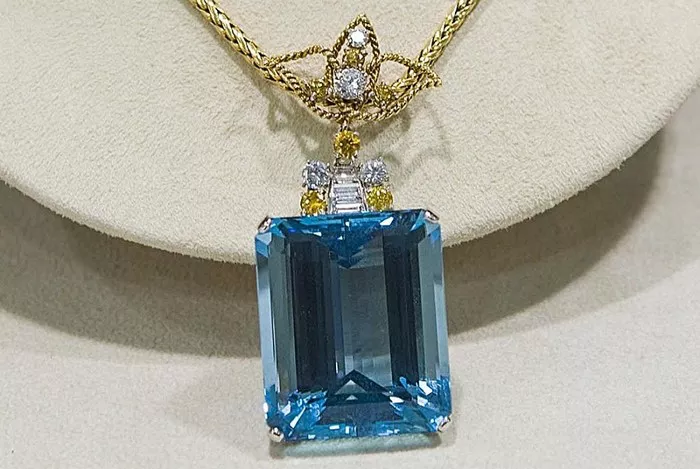Aquamarine, a captivating gemstone renowned for its tranquil hues and mesmerizing beauty, holds a unique place in the world of gemology. As a form of beryl, aquamarine boasts a composition that includes beryllium aluminum cyclosilicate, rendering it a gem of considerable allure and durability. Its range of colors, spanning from greenish-blue to pale blue, evokes images of serene oceans and clear skies, making it a favored choice in jewelry design. In this comprehensive guide, we delve into the properties of aquamarine, its durability, interaction with water, care instructions, cleaning tips, storage advice to ensure the longevity and luster of this exquisite gem.
Properties of Aquamarine
Aquamarine derives its name from the Latin words “aqua marina,” meaning “water of the sea,” owing to its captivating blue-green hues reminiscent of tranquil ocean waters. As a variety of beryl, aquamarine shares its mineral composition with emerald, morganite, and heliodor. Its chemical formula, Be3Al2(SiO3)6, underscores its crystalline structure and unique properties. Aquamarine’s colors range from a deep, vivid greenish-blue to a delicate, pale blue, with variations influenced by trace elements such as iron.
Durability
One of the defining characteristics of aquamarine is its impressive hardness, ranking between 7.5 and 8 on the Mohs Hardness Scale. This hardness places it among gemstones with excellent durability, making it suitable for everyday wear. Its resistance to scratching is notably high, although care should be taken to prevent contact with harder materials that could potentially mar its surface.
The Mohs Hardness Scale quantifies a mineral’s resistance to scratching by comparing it to other minerals. With aquamarine scoring between 7.5 and 8, it falls just below gems like sapphire and diamond, showcasing its robust nature. This hardness translates into a gemstone that can withstand the rigors of daily wear, maintaining its luster and beauty over time.
Interaction with Water
Aquamarine’s durability extends to its interaction with water. Unlike some gemstones that may be adversely affected by moisture, aquamarine can withstand exposure to water due to its hardness. However, caution is advised against prolonged immersion, as excessive exposure to water can compromise the stone’s structural integrity and surface polish over time.
While occasional contact with water, such as washing hands while wearing aquamarine jewelry, is generally harmless, extended submersion should be avoided. This precaution ensures the gem retains its brilliance and clarity, minimizing the risk of potential damage.
Care Instructions
To preserve the beauty and longevity of aquamarine jewelry, adherence to proper care instructions is paramount. Follow these guidelines to safeguard your gemstone investment:
Avoid Prolonged Submersion: Refrain from prolonged exposure to water or immersion in liquids, as this can lead to damage over time.
Protect from Harsh Chemicals: Keep aquamarine jewelry away from harsh chemicals, including household cleaners and chlorinated water, which can dull or corrode the gemstone.
Shield from Extreme Temperatures: Avoid exposing aquamarine to extreme temperatures, such as direct sunlight or rapid temperature changes, to prevent thermal shock.
By following these care instructions, you can ensure that your aquamarine jewelry retains its brilliance and allure for years to come.
Cleaning Tips
Regular cleaning is essential to maintain the sparkle and clarity of aquamarine. Follow these gentle cleaning tips to keep your gemstone looking its best:
Use Lukewarm Water: Fill a bowl with lukewarm water and mild soap.
Soak and Gently Clean: Place the aquamarine jewelry in the soapy water and let it soak for a few minutes. Use a soft brush, such as a toothbrush, to gently clean around the gemstone and settings.
Rinse and Dry: Rinse the jewelry thoroughly with clean water to remove any soap residue. Pat dry with a soft, lint-free cloth.
Avoid using harsh chemicals or abrasive cleaners, as these can damage the surface of the gemstone. Regular, gentle cleaning will help maintain the brilliance and clarity of your aquamarine jewelry.
Storage Advice
Proper storage is essential to prevent damage to aquamarine jewelry. Follow these storage tips to protect your gemstone from scratches and abrasions:
Individual Compartments: Store aquamarine jewelry in individual compartments or pouches to prevent contact with harder materials that could scratch the gemstone.
Avoid Tangles: Store necklaces and bracelets flat or hang them separately to avoid tangling and potential damage.
Periodic Inspection: Regularly inspect your aquamarine jewelry for any loose settings or signs of wear. Prompt repairs can prevent further damage and preserve the gemstone’s beauty.
By implementing these storage practices, you can prolong the lifespan of your aquamarine jewelry and enjoy its elegance for years to come.
In conclusion, aquamarine’s enchanting beauty and durability make it a prized gemstone in jewelry design. By understanding its properties, exercising caution with water exposure, following care instructions, adopting proper cleaning and storage practices, and utilizing , you can ensure that your aquamarine jewelry remains a cherished and radiant adornment for generations to come.


